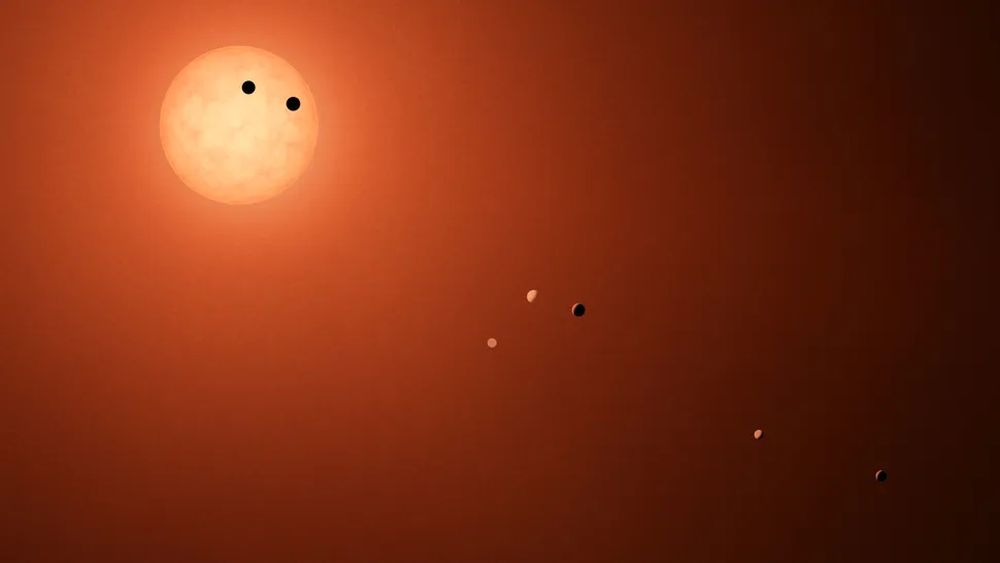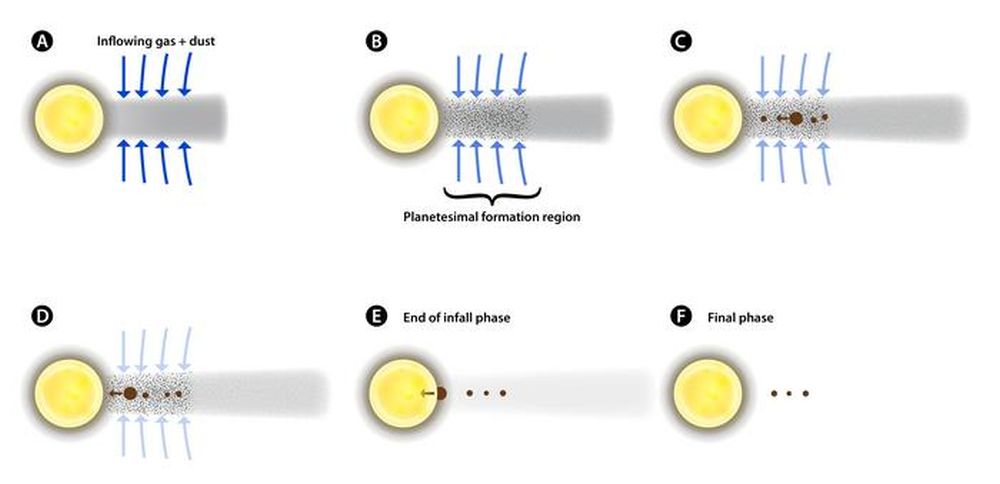A first stage in understanding a natural phenomenon is to divide it into steps and give things labels. That gives us a way to talk about the phenomenon. But in nature, there are seldom clear divisions between processes. The entire Universe is a long-running series of intertwined causes and effects set in motion by the Big Bang.
One of the phenomena scientists are working hard to understand is how compact solar systems form. Up until now, the dominant thinking was that first a star forms, then planets form. They were considered separate, discrete stages in solar system formation. Call it the "star first, planets second" model. But there are problems with that model, and they become more glaring as astronomers study other solar systems.
One of the problems is the mass distribution puzzle presented by compact solar systems. If stars form first and then planets, why do compact solar systems have so many planets with such similar masses? In the well-known TRAPPIST-1 system, all seven planets are larger than Mars, and five of them are within 15% of Earth's diameter.
 This artist's illustration shows the red dwarf star TRAPPIST-1 and the seven planets in its compact system. Image Credit: NASA
This artist's illustration shows the red dwarf star TRAPPIST-1 and the seven planets in its compact system. Image Credit: NASA
Researchers at the Southwest Research Institute (SwRI) may have figured out how compact systems form. Their new research is titled "Origin of compact exoplanetary systems during disk infall," and it's published in Nature Communications. The authors are Raluca Rufu and Robin Canup, both from the Solar System Science and Exploration Division at SwRI.
"Exoplanetary systems that contain multiple planets on short-period orbits appear to be prevalent in the current observed exoplanetary population, yet the processes that give rise to such configurations remain poorly understood," the researchers write in their article. "A common prior assumption is that planetary accretion commences after the infall of gas and solids to the circumstellar disk ends."
The conventional wisdom says that planets form after the star forms. Each solar system forms from a solar nebula, and as a young star forms, a circumstellar disk of material forms around it. This is the material that young stars draw from. Eventually, material stops falling into the circumstellar disk and its mass is fixed. After a few million years, this disk is dispersed. But before it is, planets start forming in the disk through collisions, mergers, and accretion. In this understanding, planets start forming only after material has stopped falling into the disk.
“Compact systems are one of the great mysteries of exoplanet science,” said Rufu, a Sagan Fellow and lead author of a Nature Communications article describing this research. “They contain multiple rocky planets of similar size, like peas in a pod, and a common mass ratio that is very different than that of our solar system’s planets.”
“Intriguingly, the common mass ratio seen in compact exoplanetary systems is similar to that of the satellite systems of our gas planets. These moons are thought to have developed as gas planets finalized their formation. This seems a powerful clue that compact systems may reflect a similar underlying process,” said Canup.
The Atacama Large Millimeter Array (ALMA) telescope is astronomers' best tool for observing young, still-forming solar systems because it can see through the gas and dust that shrouds them. As ALMA examines more and more young systems, it finds that planets begin forming early. How can this be understood?
“Conventionally, it has been assumed that planetary assembly started after stellar infall ends. However, recent ALMA observations provide strong evidence that planetary accretion, or formation, may begin earlier,” said Rufu. “We propose that compact systems are surviving remnants of planet accretion that occurred during the final phases of infall.”
The researchers used simulations to test the idea. They developed a model that can explain compact solar systems that's partly based on ALMA observations. It shows that planets begin forming while the star is still accreting, and that a planet migrates inward as it gains mass. This creates systems like TRAPPIST-1.
 This figure shows the formation process for compact systems of rocky planets according to the new model. Planets begin forming in regions of a disk around a young star that are fed by an ongoing infall of gas and small grains. Growing planets collect rocky material while gradually spiraling inward through interactions with surrounding gas. As a planet gains mass, its inward migration accelerates. This process creates a compact planetary system with a planets-to-star mass ratio consistent with observed compact exoplanetary systems. Image Credit: Rufu and Canup 2025. Nature Communications
This figure shows the formation process for compact systems of rocky planets according to the new model. Planets begin forming in regions of a disk around a young star that are fed by an ongoing infall of gas and small grains. Growing planets collect rocky material while gradually spiraling inward through interactions with surrounding gas. As a planet gains mass, its inward migration accelerates. This process creates a compact planetary system with a planets-to-star mass ratio consistent with observed compact exoplanetary systems. Image Credit: Rufu and Canup 2025. Nature Communications
“We find that planets that accrete during infall can survive until the gas disk disperses and orbital migration ends,” said Canup. “Importantly, across a broad range of conditions, the mass of surviving systems is proportional to the mass of the host star, providing the first explanation for the similar mass ratios of observed multi-planet compact systems.”
The process presented in their model is somewhat parallel with the moon-forming process around gas giants like Jupiter. As a gas giant forms, a ring of material forms around it, fed from the circumstellar disk. Just like planets forming around a star, moons form in the disk around the gas giant. The two processes aren't exactly the same, though. The planet-forming disks around stars can persist for millions of years, while the moon-forming disks quickly disperse once infall from the circumstellar disk ceases.
“It’s exciting to see that the process of early assembly in young disks may work in a similar way across very different scales,” the team notes.
"Predictions of our model should be increasingly testable by observations," the SwRI researchers explain in their article. "Accretion during infall implies a common compact system mass ratio independent of stellar mass, and that systems with somewhat lower estimated mass ratios might host yet undetected planets."
There are, of course, outstanding questions. For example, how larger planets form in this model is still unclear. The authors write that planets that survive while forming during infall, and their characteristics, depend largely on the radial extent of disk infall (rc) and the ratio of the gas disk lifetime to the infall timescale (β). However, their simulations only involved small rc and small β cases, consistent with compact systems.
"Most broadly, our results suggest that the long-standing assumption that planet accretion commences only after infall has ended may not be valid for all systems, and consideration of this early accretionary phase is warranted," the authors conclude.

